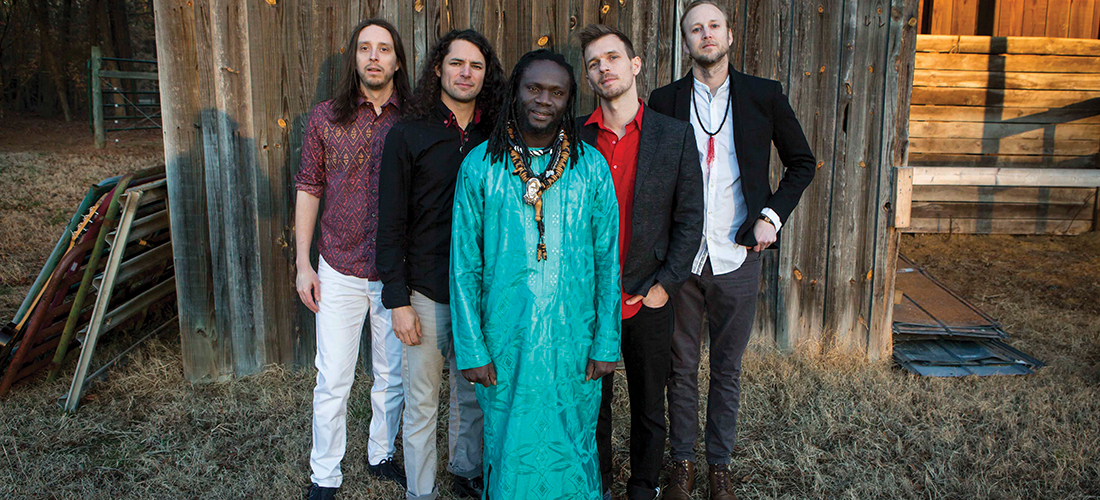Raman Bhardwaj sends big messages with oversize art
By Maria Johnson • Photographs by Lynn Donovan
Artist Raman Bhardwaj stands so close to movie star Lupita Nyong’o, he can feel the heat coming off of her, and she is flat sizzling.
Neither wears a mask — worrisome behavior in these Covid-19 times — but it’s OK because Bhardwaj is painting the actress’s face on an outdoor mural that’s catching the late afternoon sun.

“I can’t stand the heat,” Bhardwaj says casually. His last name is pronounced BARD-wadj. First name: RUM-an, “Like in rum and Coke,” he says.
As a native of India, he cannot claim this is his first experience with furnace-like temperatures, but he is undeterred. Shade from a curtain of trees crawls his way.
He pours a stream of glossy black latex into a tray and soaks a paint roller to do Nyong’o’s hair.
“Usually you would start a picture from the top down,” Bhardwaj explains as he steps up to his sweltering work. “If something goes wrong, I’ll fix it. I’ll take the risk.”
He crowns Nyong’o in broad strokes. The paint does not cover completely, and the effect is softening.
“I wasn’t expecting this,” Bhardwaj says, stepping back. “It’s good.”
Just then, the roller attachment drops off its handle, landing in the recently bulldozed dirt of the Kotis Street Art Outdoor Gallery.
“Uh-oh,” says Bhardwaj.


He snatches up the sticky roller, picks off the biggest pieces of crud and continues painting, standing on the toes of his paint-splattered Crocs until he cannot reach any higher.
He tries a longer handle, but it doesn’t work, so he reverts to the short handle, drags a ladder to the wall and continues working on Nyong’o, who won an Oscar for her supporting role in the 2013 film 12 Years a Slave.
Gently, Bhardwaj wipes a drip of black paint from her left ear, picks up a can of nutmeg-colored spray paint and replaces a curved ridge of cartilage. Pssst. A thin line of black under her left eyelid. Pssst. A white gleam in the center of her iris. Pssst. A touch of sienna in the white of her eye.
“Our brain thinks it’s white, but it’s actually not,” says Bhardwaj.
A breeze sweeps away puffs of paint that do not make it to Nyong’o’s striking face, a visage Bhardwaj chose to venerate the beauty of brown-skinned women.
Marty’s brush. That’s what some people call Bhardwaj, meaning he’s the go-to painter of Greensboro developer Marty Kotis, father of the local street-art scene.



It’s a remarkable nickname for the 44-year-old artist, considering that he had never painted a mural, much less tagged a wall with graffiti, before last year.
“In my hometown, we had no culture of murals,” says Bhardwaj, who was weaned on paper and canvas. He grew up in the northern Indian city of Chandigarh and landed in Greensboro on an artist’s visa in 2018.
Now, a year after Kotis handed him a spray can, Bhardwaj has finished 29 projects, a healthy slice of the 220 works created under the umbrella of Kotis Street Art in its four-year history. (See September 2018’s ohenrymag.com/painting-the-town/)
Bhardwaj has a strong presence at the developer’s latest project, an outdoor gallery of pole-mounted panels near the corner of Church Street and Lees Chapel Road.
Not only is Bhardwaj’s mural of Nyong’o’s face prominent there — you can’t miss her; she’s the one with a third eye of consciousness on her forehead — his work covers almost every vertical surface in the adjacent Church Crossing shopping center, which Kotis owned for seven years before making it a venue for aerosol art.
The caramel whorls painted on stucco over Millie Nails? They’re Bhardwaj’s. The stout round columns covered with brown faces and Hindi letters? His. The Marvel Comics and DC Comics characters duking it out on a retaining wall? Those are Bhardwaj’s, too. At Kotis’s direction, he darkened the complexions of some characters. Witness a Captain America that looks more like America — and Greensboro.
“We wanted a welcoming wall that inspired kids of different colors and nationalities,” says Kotis.
Bhardwaj’s art is not limited to the walls of Kotis holdings.
In the wake of George Floyd’s killing in Minneapolis, Minnesota, on May 25, Bhardwaj took to the streets of downtown Greensboro with other supporters of the Black Lives Matter movement.
The activism resonated with him. As a dark-skinned child, he felt the sting of prejudice. Though he was born a Brahmin, the highest social caste, he watched as his teachers lined up the lightest-skinned students in the front rows for class pictures.
“I thought, ‘OK, the fair-skinned kids have a better chance than me,” he says. “It acts on your confidence level. I can connect with the Black community.”
In late May, he joined other Greensboro artists who got approval from business owners to express themselves on plywood that protected plate glass from looters.
Bhardwaj painted two murals at Little Brother Brewing. One shows two boys — one Black, one White — with their arms around each other. The other shows a dark hand and a light hand curled to form a heart shape. The panels have been moved to Guilford Preparatory Academy, a charter school on East Cone Boulevard.
“They’re going to appeal to kids,” he says. “Even if you’re not paying attention, images are stored in your head, and they have an effect.”
Last year, his piece Flights of Fancy, a dreamy green vision of floating people and animals, was posted on billboards across the Piedmont. The surreal piece was one of five local winners of ArtPop, a national contest sponsored in this area by the Arts Council of Winston-Salem and Forsyth County.
Bhardwaj’s submission was grounded in his own feelings about immigration.
“I was thinking of a free land, with no borders, where people can fly anywhere,” he says. “I like to dream happy. No matter how big you are, everybody likes magic.”
As a child growing up in Chandigarh, a city laid out by French-Swiss architect Le Corbusier (picture lots of traffic circles), Bhardwaj was fascinated by religion and mysticism.
He built an altar to Hindu gods in his room at age 4.
By the time he was 6, he was known as the kid who recited long chants and prayers.
“I could memorize anything and retain anything,” he says. “I was good in studies for the same reason.”
One day, after looking at a classmate’s drawing of the popular comic strip character Daddy-Ji, Bhardwaj went home and drew Daddy-Ji for himself.
“I drew it for many days,” he says. “I was trying to perfect it. The day I could draw it without looking at the picture, I was like, ‘Yes!’”
Soon, he was known as the kid who spouted prayers and drawings. Gradually, art replaced religion as his obsession. He shunned sports, which he found to be populated by bullies.
“I was intimidated,” he says.
He made peace powerful in pencil and paper, which he used to detail the musculature of athletes, superheroes and mythical figures. Bhardwaj imagined that he, too, possessed the powers to overcome his weaknesses and help others.
His favorite hero was Batman, righter of wrongs.
Bhardwaj’s father, a city college official and editor of a literary magazine, divined a career for his younger son: illustrator.
He introduced him to a children’s book publisher, and Bhardwaj, age 12, had his first professional gig, drawing pictures for moralistic books by the writer Munshi Premchand.
Bhardwaj earned 10 rupees — about 60 U.S. cents in those days — per illustration. A book contained 10 to 15 images. “For one book, I would get more than my monthly allowance, so I was happy,” he says.
At age 19, while studying art at a local art college, Bhardwaj won a national award for his illustrations.
Emboldened, he asked the college gallery for a one-man show of his figure drawings. He was denied, but he landed a show at a city museum. He also got an encouraging review after badgering a tough critic, S.S. Bhatti, to see his work.
Today, Bhardwaj reflects on the chutzpah he mustered as a young man.
“I wanted to prove something to everyone, always,” he says. “Even in school, I dreaded failure, so I over-prepared. It was out of fear of failure.”
Fear propelled him to the top of his profession. He won recognition as a newspaper illustrator and designer at The Indian Express and The Times of India, both daily behemoths.
He also expanded the sideline he’d started at age 12, illustrating children’s books and, thanks to the growing reach of the Internet, generating logos and animations for business websites.
Bhardwaj preferred Western clients to Indian clients. They were more polite, he thought, and they paid better.
“I felt like they were more honest and appreciated me,” he says.
He became a pure freelancer in 2010, and he thought about moving to the West, but family ties kept him in India until his mother’s sudden death in 2017.
“After that, I thought, ‘I have to go now. Life is short,’” he says.
He applied for an artist’s visa that would allow him to stay in the United States for three years.
In March 2018, he landed in Greensboro, where his brother lives. Bhardwaj liked the city immediately. It reminded him of home.
“It’s clean and green and sleepy,” he says. “I like sleepy.”
He hadn’t been here long when he added an item to his bucket list: “I cannot die without doing a wall.” Murals, with their oversize scale and impact, mesmerized him. “Content-wise, they can be grand,” he says. “I like to do grand things.”
By the summer of 2019, Bhardwaj had painted his first two murals, one inside the Greensboro Cultural Center and one facing a covered patio at The Brewer’s Kettle, a beer hall in Kernersville.
He was itching to tackle more visible pieces, but he was nervous.
“I’m not ready,” Bhardwaj told his friend Bill West, a musician from Chapel Hill.
“You’ll never be ready,” said West, as he handed Bhardwaj the web address for Kotis Street Art.
Bhardwaj and Marty Kotis had coffee. Kotis offered him a trial run inside his Red Cinemas, a movie multiplex blanketed, inside and out, with wall art. Wielding spray cans for the first time, Bhardwaj painted caricatures of two Bollywood stars, Shah Rukh Khan and Amitabh Bachchan.
Kotis offered another space, on the backside of Saffron Indian Cuisine in the Westover Gallery of Shops. Bhardwaj brushed on a giant ballerina.

He spray-painted his next piece, Heath Ledger’s Joker from The Dark Knight, which haunts the backside of Red Cinemas.
Kotis was floored, not only by the composition, but by how quickly Bhardwaj learned to use spray cans and the “doodle grid” system that most street artists use to accurately transfer digital images to large walls.
He was even more impressed when Bhardwaj squeezed another version of the criminal clown — based on Joaquin Phoenix’s portrayal in Joker — into a doorway in the back of the theater.
“That’s extremely difficult, to aerosol that small a character,” says Kotis. “There’s not a lot of room for error.”
Next, Bhardwaj busted out a shirtless Bruce Lee on the back of World of Beer the Westover Gallery. After that, Kotis, who’d been providing the artist with supplies and food, started paying him for commissions.
Last year, on the 25th anniversary of the Community Theatre Group’s performance of The Wizard of Oz, Bhardwaj and Kotis cooked up a tribute. Bhardwaj would paint 13 Wizard scenes on Kotis properties all over town, creating a scavenger hunt for fans of the film.

But first, Bhardwaj had to watch the movie.
“Now I see what everyone is so excited about,” he says. “I love that movie. It’s great, great storytelling.”
Increasingly, Bhardwaj paints murals in private homes. For one client, a basketball fan, he plastered Michael Jordan across a carport wall. For Jeanie Duncan and her partner Lyn Koonce, who live on the edge of Fisher Park, Bhardwaj blanketed one dining room wall with a condensed panorama of the park. Using a brush to achieve the look of a pen-and-ink drawing spiced with splashes of color, he folded in the couple’s favorite features of the neighborhood: antique street lights; stone bridges; the masonry King’s Chair; rocks in the creek; and wildlife such as rabbits, squirrels, birds and dragonflies.
He finished the piece in July.
“We can’t wait to share it with others,” says Duncan, who’s eager for coronavirus to subside. “It’s a conversation piece between the two of us. I can only imagine what it will be among friends and family.”
In the post-Covid world, Bhardwaj wants to pick up where he left off, doing local shows of his paintings on canvas. His studio pieces whisper the influences of Pablo Picasso, Marc Chagall and Henri Matisse.
These days, he paints mostly women, including nudes, a practice scorned in many places in India.

“I still find in Greensboro some people are not comfortable with it, but it’s not dangerous. It’s not like people can come to your gallery and mess up your show and take down your paintings,” he says.
Bhardwaj hopes to get a three-year extension of his visa, which runs out at the end of this year. He’s gathering contracts to justify staying. He’d like to get a Green Card, indicating permanent residency, and become a U.S. citizen.
For all of this country’s problems, he says, it’s a fertile place to be an artist. The average person here knows much more about art than his compatriots back home.
“Here, even if I’m alone among foreigners, we still have the connection with art, which is my life.” OH
See Bhardwaj’s work on Instagram @artistraman or
www.artistraman.com.





























